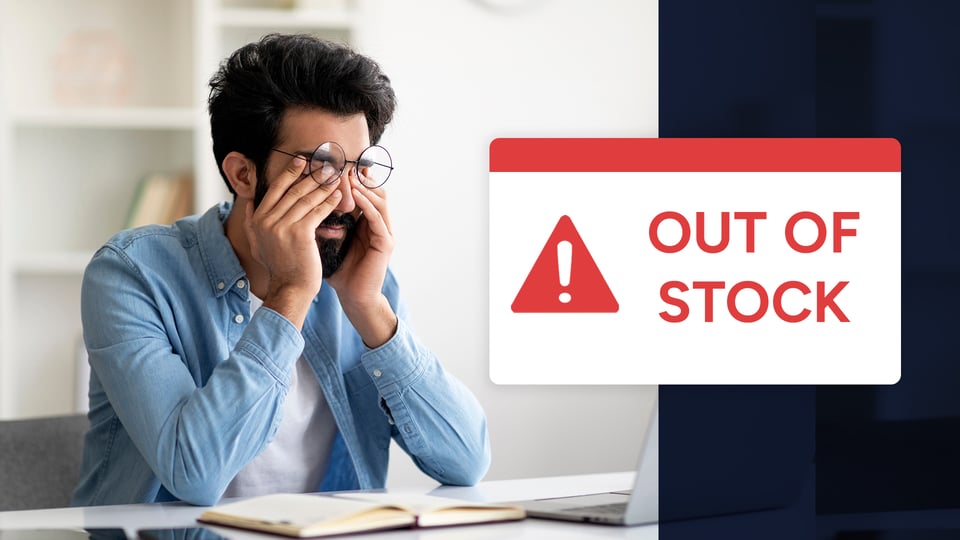What is overselling?
Simply put, overselling is when a brand or retailer accidentally sells more products than in its inventory. Sometimes, businesses have not correctly integrated their WMS (warehouse management systems) with the marketplaces and sales channels they’re selling on. This mismatch in inventory management and product listings can lead to one of two issues: stockouts or overselling.
Stockouts: This is when your brand runs out of inventory. An out-of-stock item means a customer cannot purchase the product, leading to a lost sale. 30% of consumers feel that stockouts hurt their shopping experience, and after three such stockouts, 70% will choose to shop at a competitor.
Overselling: This is when there are systemic errors in your brand’s tech stack. The WMS and inventory management systems don’t accurately reflect the stock available. In turn, customers may end up purchasing products that you don’t actually have. You may have to issue refunds and further compensate the customers for this.
Obviously, stockouts and overselling lead to considerable dissatisfaction and frustration for both the customers and the brand. On the flip side, addressing stockouts and over-stocking can help businesses reduce inventory costs by 10%.
The biggest reason for stockouts and overselling for ecommerce brands is Inventory Record Inaccuracy (IRI). IRI means that your business has wrongly recorded the amount of inventory available and the amount of inventory listed for customers to purchase. IRI can lead to a loss of more than 1% of all your sales and more than 3% of your gross profit.
Why is it a bad thing to oversell products?
Along with the monetary loss due to a lost sale or additional costs to issue refunds, overselling has some critical problems that can impact a brand:
Damage to your brand image & reputation
When you sell products you don’t have, you risk considerable damage to your brand image and reputation. Whether intentional or unintentional, overselling makes customers feel betrayed by your brand. This betrayal of trust can result in poor social media reviews, backlash in the form of feedback, and, in extreme cases, legal intervention. Customers who feel like they wasted time trying to purchase from your brand are less likely to return for future purchases, so you can kiss brand loyalty goodbye. In fact, they may even actively discourage others from buying from your brand. In today’s interconnected world, word-of-mouth can spread quickly, amplifying the damage to your reputation.
Revenue loss
The most important reason to prevent overselling is the loss of revenue your brand will face. Without accurate or up-to-date stock information on marketplaces, you risk losing customers who may go to a competitor to complete their purchase. This results in revenue loss. If this keeps happening, you may drive customers away for good. However, 69% of consumers will try to buy another product after the first time they encounter a stockout, so brands still have a chance to make that sale.
Lost resources & time
Not only do you lose a sale when you accidentally oversell, but you also have to deal with a host of other issues that will most assuredly take up additional time and resources. Unhappy customers who made a purchase you don’t have the stock to fulfill will request refunds or dispute charges with their credit card companies. These activities cost you money in processing fees & return logistics and tie up resources that could be used more effectively elsewhere.
You’ll also need to invest time and resources into addressing overselling. This might involve issuing refunds, replacing products, or compensating disappointed customers.
Amid all this, you may also have to answer key stakeholders about overselling and how it’s negatively impacted your sales, revenue, and image.
How can brands prevent overselling?
Sometimes, mistakes happen. Perhaps there was a technical error or a misguided intention to increase sales, not expecting the demand. For brands and retailers who want to take proactive steps to prevent overselling, we’ve got you covered:
Implement inventory management best practices
One of the first things to do to avoid overselling is to know exactly how much inventory you have ready to sell. 46% of small-to-medium businesses don’t track inventory or use a manual method. If your business does inventory management manually, you are bound to run into errors again and again. Add in multiple marketplaces and sales channels and manually updating inventory becomes time-consuming, labor-intensive, and extremely slow.
Robust and innovative inventory management practices are critical to help you reduce stockouts and overselling. Best practices recommend that you should:
- Conduct regular physical inventory audits to ensure accuracy in your warehouse.
- Use historical sales data and market trends to predict future demand and plan inventory accordingly. A combination of audits & demand forecasting can help you prepare for sales accurately.
- Maintain a safety/buffer stock to account for unexpected increases in demand or supplier delays can help you continue selling without overselling.
P.S. Knowing the difference between keeping a buffer stock and wasting your inventory away in warehouses is essential. Analytics and demand forecasting can help you balance that correctly. According to Bain & Co, 56% of retail and consumer goods sellers plan to increase their investment in demand forecasting and predictive planning.
Integrate the right ecommerce tools to help
One of the most effective ways to prevent overselling is to use ecommerce or marketplace integration software. This can help your brand ensure that stock levels on various marketplaces and webshops accurately reflect the inventory in your warehouse management system. Some key features to look for in your chosen marketplace integrator or ecommerce sales platform:
- Real-time inventory updates:
Brands selling on different sales channels and marketplaces need real-time synchronization between their inventory management system and online sales channels. This means the software updates the available quantity across all platforms as soon as a product is sold, preventing overselling due to outdated stock levels. - Automatic alerts:
Set up inventory thresholds and receive automatic alerts when stock levels reach a certain point. This proactive approach allows you to restock products before they run out, reducing the risk of overselling. - Centralized inventory management:
Managing all your sales channels and inventory from one central dashboard makes tracking stock levels easier, forecasting demand, and making informed decisions about product availability.
Monitor & implement customer feedback
Keep a close eye on customer feedback through reviews, social media, and customer service interactions. This feedback can provide valuable insights into whether you’re constantly running into stockouts or overstocking inventory. Ensure you tap into consumer demand without over-ordering and wasting warehouse space.
The key takeaway should be that sometimes, overselling happens even with the best intentions and tools. However, the goal for brands is to take every opportunity to mitigate the chances of overselling from the get-go. The right tools coupled with proactive approaches can only result in higher customer loyalty and, in the long term, higher sales & profits.
At ChannelEngine, we’ve had plenty of experience working with brands and retailers who accidentally oversold their products. When they switched to our solution, our centralized and automated dashboard helped them reduce the chances of it happening again.
For example, if your brand runs out of stock or can’t fulfill orders from one warehouse, you can set rules and automatically change fulfillment to any other warehouse or 3PL on ChannelEngine. Not only that, we also help brands set limits so they don’t accidentally list and sell products that they don’t have - which, as we know, can result in some very disgruntled customers.
Leveraging ChannelEngine to eliminate overselling
Technology is at the forefront of solutions to prevent overselling. Modern tools and platforms can help businesses maintain accurate inventory data, synchronize across multiple channels, and respond to demand fluctuations in real-time.
Our platform provides businesses like yours unparalleled capabilities to avoid overselling while maximizing sales potential. Here’s how we can help:
- Real-Time inventory management: ChannelEngine ensures that inventory data is consistently updated across all sales channels. This eliminates the risk of selling products that are out of stock on any given platform.
- Automated order management: With ChannelEngine, orders from different marketplaces are consolidated into a single system. This streamlines operations and ensures that stock levels are accurate at all times.
- Demand forecasting: By leveraging data analytics, ChannelEngine helps businesses predict trends and plan inventory accordingly, reducing the risk of stockouts or overstocking.
- Dynamic pricing and promotions: Our platform enables businesses to optimize pricing strategies without jeopardizing stock availability, ensuring profitability without overselling.




